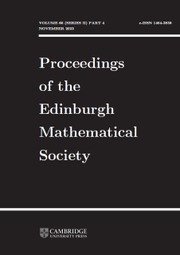No CrossRef data available.
Article contents
Congruences modulo powers of 5 for partition k-tuples with 5-cores
Published online by Cambridge University Press: 17 June 2025
Abstract
A partition is called a t-core if none of its hook lengths is a multiple of t. Let  $a_t(n)$ denote the number of t-core partitions of n. Garvan, Kim and Stanton proved that for any
$a_t(n)$ denote the number of t-core partitions of n. Garvan, Kim and Stanton proved that for any  $n\geq1$ and
$n\geq1$ and  $m\geq1$,
$m\geq1$,  $a_t\big(t^mn-(t^2-1)/24\big)\equiv0\pmod{t^m}$, where
$a_t\big(t^mn-(t^2-1)/24\big)\equiv0\pmod{t^m}$, where  $t\in\{5,7,11\}$. Let
$t\in\{5,7,11\}$. Let  $A_{t,k}(n)$ denote the number of partition k-tuples of n with t-cores. Several scholars have been subsequently investigated congruence properties modulo high powers of 5 for
$A_{t,k}(n)$ denote the number of partition k-tuples of n with t-cores. Several scholars have been subsequently investigated congruence properties modulo high powers of 5 for  $A_{5,k}(n)$ with
$A_{5,k}(n)$ with  $k\in\{2,3,4\}$. In this paper, by utilizing a recurrence related to the modular equation of fifth order, we establish dozens of congruence families modulo high powers of 5 satisfied by
$k\in\{2,3,4\}$. In this paper, by utilizing a recurrence related to the modular equation of fifth order, we establish dozens of congruence families modulo high powers of 5 satisfied by  $A_{5,k}(n)$, where
$A_{5,k}(n)$, where  $4\leq k\leq25$. Moreover, we deduce an infinite family of internal congruences modulo high powers of 5 for
$4\leq k\leq25$. Moreover, we deduce an infinite family of internal congruences modulo high powers of 5 for  $A_{5,4}(n)$. In particular, we generalize greatly a recent result on a congruence family modulo high powers of 5 enjoyed by
$A_{5,4}(n)$. In particular, we generalize greatly a recent result on a congruence family modulo high powers of 5 enjoyed by  $A_{5,4}(n)$, which was proved by Saikia, Sarma and Talukdar (Indian J. Pure Appl. Math., 2024). Finally, we conjecture that there exists a similar phenomenon for
$A_{5,4}(n)$, which was proved by Saikia, Sarma and Talukdar (Indian J. Pure Appl. Math., 2024). Finally, we conjecture that there exists a similar phenomenon for  $A_{5,k}(n)$ with
$A_{5,k}(n)$ with  $k\geq26$.
$k\geq26$.
MSC classification
Information
- Type
- Research Article
- Information
- Proceedings of the Edinburgh Mathematical Society , Volume 68 , Issue 4 , November 2025 , pp. 1245 - 1261
- Copyright
- © The Author(s), 2025. Published by Cambridge University Press on Behalf of The Edinburgh Mathematical Society.


